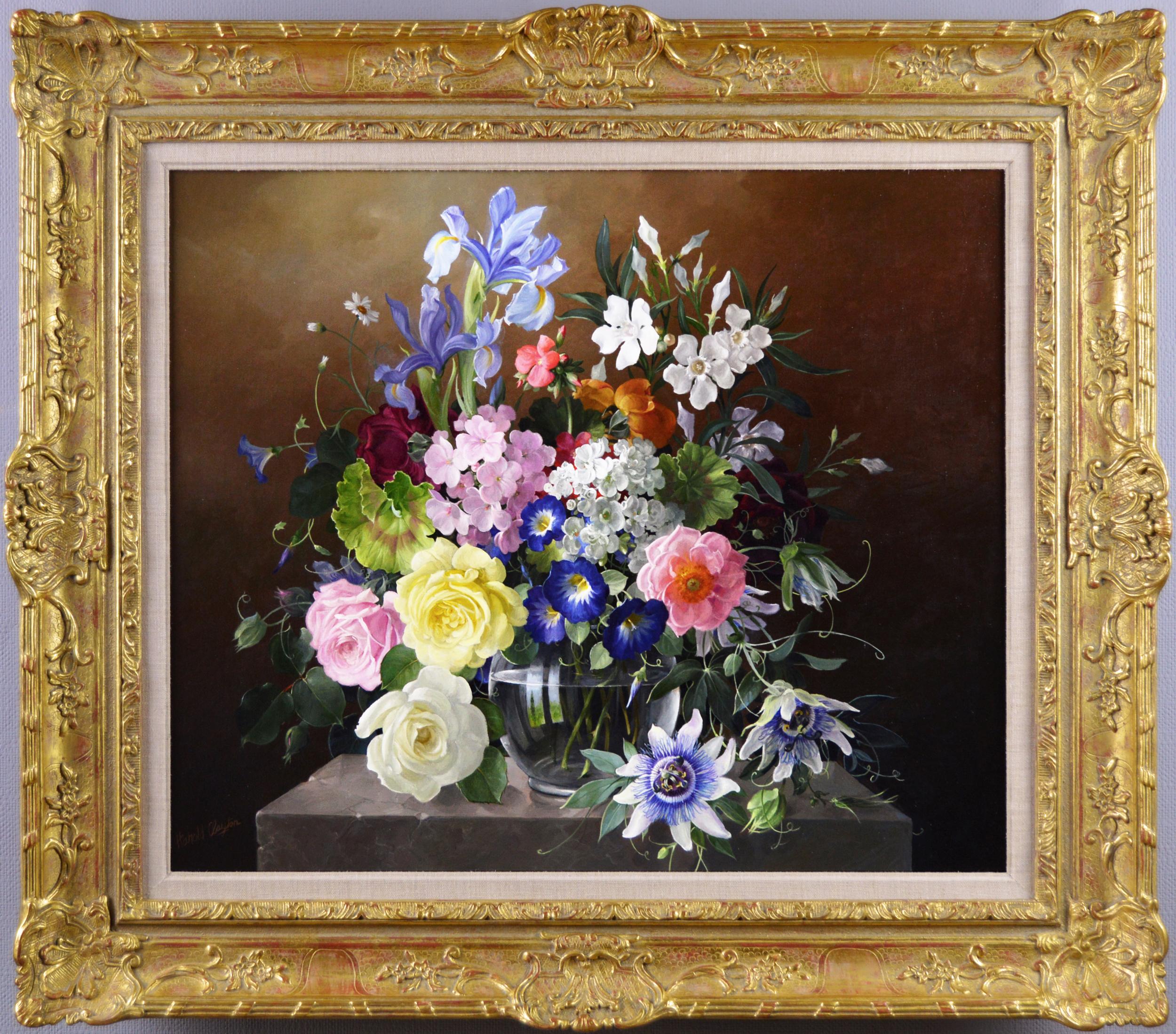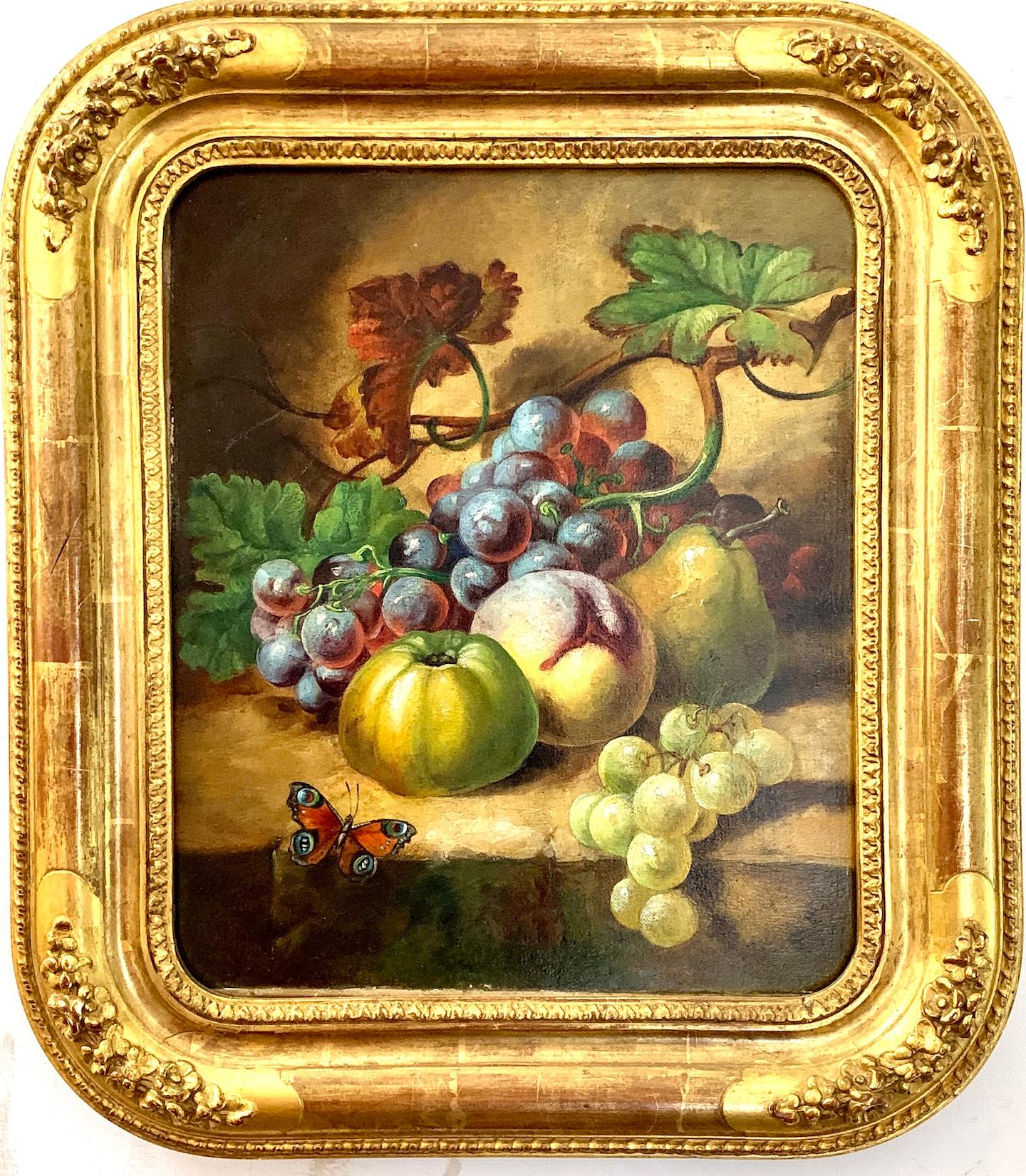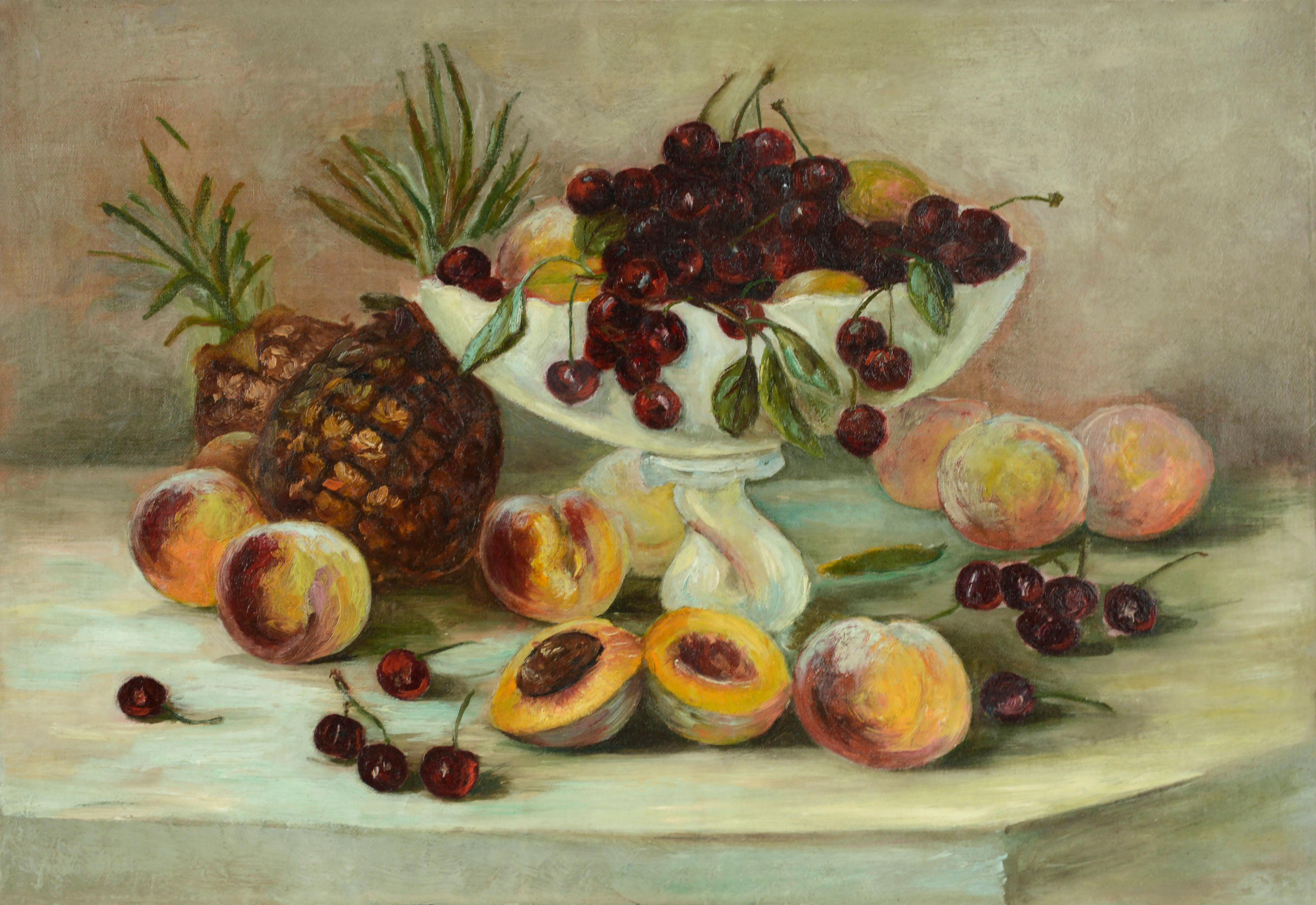Items Similar to 'A Still Life of Roses, grapes and an Ivory Vase' an antique oil painting
Want more images or videos?
Request additional images or videos from the seller
1 of 11
Edward Ladell'A Still Life of Roses, grapes and an Ivory Vase' an antique oil painting
About the Item
Edward LADELL
Picture Size: 20 x 16" (50 x 40cm)
Outside Frame Size: 26 x 22" (65 x 55cm)
An exquisite example of Ladell's painting. Signed with his traditional stylistic monogram, this painting boasts the luscious flowers and rich, sweet looking fruit on a marble ledge with an ivory jar that he is famous for.
Free shipping
1821 - 1886
Edward Ladell’s obituary in The Essex County Standard considered him ‘the foremost man of his day in fruit painting.’ He was entirely self-taught, having initially followed the profession of his father, Christmas Ladell, as a coachbuilder. A native of Colchester, he moved to Torquay and later to Exeter where he took a studio at 20 Queen’s Street. He exhibited at the Royal Academy between 1856 and 1886, and also at the British Institute, the Royal Society of British Artists, Suffolk Street and local West Country venues. Ladell became immensely successful and the finest English still life painter of his generation.
Ladell specialised in still lifes composed of fruit, flowers and a variety of objects including glass, tankards, china vases and bird’s nests. His technique achieved an astonishing degree of realism. Ladell’s paintings are always easily recognisable as he used to use the same articles over and over again on a marble ledge draped with an oriental rug. His work was much sought after and they often ensured flattering notices from the leading representative journals. His biographer Frank Lewis writes: ‘he paints with the fidelity of an old Dutchman and with the brilliancy of colour all of his own. A dead duck lying upon a board, as represented by Mr. Ladell, is a duck indeed...maybe it’s a branch from a raspberry bush laid carefully down, and while the fruit is round and luscious, over-ripe or scarcely ripe, the leaves whether fresh or fading, are represented with a verisimilitude that is marvellous.’
His wife, Ellen Maria Ladell, neé Levitt, whom he married in 1878, was also a painter and worked from 1856 to 1898. She painted in a style almost identical to her husband’s however she usually signed with her full name, whereas Edward used the EL monogram back-to-back.
The work of Ladell is represented in the Bristol City Art Gallery, the Colchester and Essex Museum, the Royal Albert Memorial Museum in Essex, the Harrogate City Art Gallery, the Reading City Art Gallery and the Mappin Art Gallery, Sheffield.
Ladell specialised in still lifes composed of fruit, flowers and a variety of objects including glass, tankards, china vases and bird’s nests. His technique achieved an astonishing degree of realism. His biographer Frank Lewis writes: ‘he paints with the fidelity of an old Dutchman and with the brilliancy of colour all of his own. A dead duck lying upon a board, as represented by Mr. Ladell, is a duck indeed...maybe it’s a branch from a raspberry bush laid carefully down, and while the fruit is round and luscious, over-ripe or scarcely ripe, the leaves whether fresh or fading, are represented with a verisimilitude that is marvellous.’
The work of Ladell is represented in the Bristol City Art Gallery, the Colchester and Essex Museum, the Royal Albert Memorial Museum in Essex, the Harrogate City Art Gallery, the Reading City Art Gallery and the Mappin Art Gallery, Sheffield.
- Creator:Edward Ladell (1821 - 1886, British)
- Dimensions:Height: 26 in (66.04 cm)Width: 22 in (55.88 cm)Depth: 2 in (5.08 cm)
- Medium:
- Movement & Style:
- Period:
- Condition:Provenance: Christies It is in an antique frame.
- Gallery Location:St. Albans, GB
- Reference Number:1stDibs: LU2469212805502
About the Seller
5.0
Gold Seller
These expertly vetted sellers are highly rated and consistently exceed customer expectations.
Established in 1965
1stDibs seller since 2023
19 sales on 1stDibs
Typical response time: 2 hours
- ShippingRetrieving quote...Ships From: St. Albans, United Kingdom
- Return PolicyA return for this item may be initiated within 7 days of delivery.
More From This SellerView All
- A Still Life of FlowersBy Dorothea SharpLocated in St. Albans, GBA wonderful example of Dorothea Sharp's still lifes. Full of vibrancy and effervescence this painting ,with her classic broad brush strokes, show her talent at its best. It is in a w...Category
Early 20th Century Impressionist Still-life Paintings
MaterialsOil
- A Still Life of Figs and MelonLocated in St. Albans, GBJean Baptiste Olive This premiere piece shows his work and influence which he had with Antoine Vollon. It is in its museum quality gold leaf frame. The piece has been exhibited in many shows with the exhibition labels on the reverse testimony. Artwork Size: 22 x 18" (56 x 46cm) Artwork Size with Frame: 31 x 27" (79 x 69cm) Free Shipping French, 1848-1936 Jean-Baptiste Olive was undoubtedly one of the greatest masters of the Marseille school at the end of the 19th century, along with Paul Guigou...Category
Late 19th Century Impressionist Still-life Paintings
MaterialsOil
- Nature Morte - A Still Life , Oil on CanvasBy Claude VernardLocated in St. Albans, GBClaude Venard 1913 - 1999 This painting comes with a certificate of authenticity. Canvas Size: 21.5 x 25.75" (54 x 65cm) Outside Frame Size: 29.5 x 33.75" (73.75 x 84.25) Claude ...Category
Late 20th Century Abstract Abstract Paintings
MaterialsOil
- Un Bouquet de Fleurs SpectaculaireBy Marcel DyfLocated in St. Albans, GBMarcel DYF 1899 - 1985 Oil on canvas Canvas Size 28 x 23" (72 x 60cm) Outside Frame Size: 36 x 31" (92 x 80cm) Free Shipping Dyf’s family lived in Paris, but he spent his childhood holidays in Normandy at Ault, Deauville, and Trouville. The artistic climate to which he was exposed in Paris and in Normandy was crucial during his youth, as innovative ideas and new thinking, born of the Impressionist and Post-Impressionist movements, formed ever widening circles of influence in Europe. Swept up in the atmosphere, Dyf decided in his early twenties to give up his career in engineering and become an artist. He moved to Arles in 1922 to pursue his calling and he kept a studio there until 1942. He had little formal artistic training but owed much of his inspiration to the great masters of the past such as Rembrandt, whom he particularly admired, Vermeer and Tiepolo. In Provence, challenged by a new range of colours and light, by new landscapes and images and under the same intense sky that lent its brilliance to Van Gogh’s art, Dyf graduated from painter to artist. Whilst living in Arles, Dyf was commissioned to paint a number of large historical and decorative works, mostly frescoes, in the town halls of Saint Martin-de-Crau and Les Saintes Maries-de-la-Mer, in Arles, in the Museon Arlaten and in the dining hall of the Collège Ampère. He also designed windows for the church of Saint Louis in Marseille. In 1935 Dyf took on Maximilien Luce’s old studio in the Avenue du Maine on the left bank. His partial return to Paris meant that he could work with many whose names became renowned for their highly original contributions to art, music, and literature. Paris hummed with creative vitality in the 1930s and Dyf was both participant and recipient in the atmosphere. Paris was shattered by the invasion of 1940. Like many others, Dyf left the city and returned to Arles, but he quickly had to abandon his home in the south and he took to the Maquis, entering the Résistance in Corrèze and the Dordogne. After the Liberation he returned to Arles to find the studio reduced to rubble in the fighting. He retreated, heavy-hearted, to Paris but the pull of the Midi was deep-rooted, so in time he returned and made a new base in Saint Paul-de-Vence. Thereafter he divided his time between Paris and the south. His pictures began to sell through galleries in Cannes, Nice, Marseille and Strasbourg. In Paris he exhibited and sold his paintings through the Salon d’Automne, the Salon des Tuileries and the Salon des Artistes Français. In the first half of the 50s Dyf worked in Paris throughout the winter and spent the summer in Cannes, where he set up a studio-gallery and established a regular following among American visitors to the Riviera. In 1955 the first paintings were bought from Dyf by Frost & Reed to be sold in London, thus heralding the formation of a remarkable and enduring relationship between artist and gallery. In the summer of 1954, Dyf met Claudine Godat. Aged 19, she was thirty-six years younger than Dyf and with her long fair hair, clear skin, vivacity and patience, she was what the artist felt to be his perfect model. It was simply love at first sight. There was an instant rapport between them and her arrival in his life acted as a catalyst, bringing Dyf’s art forward to the threshold of its most mature phase. In 1956, they married and bought a 16th century hunting lodge at Bois d’Arcy, near Versailles. This became their main home, but each winter they returned to Provence on painting trips, staying in Saint-Rémy or in the small village of Eygalières. The olive trees, the cane windbreaks and the grey-white crags of the Alpilles provided countless motifs for Dyf’s paintings of Provence, and his artistic and emotional attachment to the area endured to the end of his life. In 1960, at Claudine’s insistence, they first visited Brittany. They explored widely and finally came upon the Golfe du Morbihan. Dyf was enchanted with this remote, beautiful region. He immediately saw the potential for new subjects, in the still waters of the huge lagoon surrounded by rolling fields of wheat and tiny clusters of slate-roofed cottages, and he knew he must return to paint there. From that time on the seasons of the year followed the same pattern: autumn was spent at home near Versailles and in the late autumn or early spring Dyf and Claudine drove south and spent six or eight weeks in Provence. In May they left for Brittany, where they spent the summer in a house they had bought opposite the church in the village of Arzon. Two or three times a year Frost & Reed would visit Dyf and buy all the best of his works for their stock. Dyf could never work in an empty studio, he said that it deadens an artist’s inspiration, so immediately the paintings had left for London, he and Claudine would set off to the west or to the south in search of new inspiration. This annual round having been established, there followed many years of great fulfilment. The artist, free from the burden of running the more mundane side of his life, was now able to devote all his time to painting and through Frost & Reed, his sole world agent, he was guaranteed an outlet for his work. To watch Dyf paint was entrancing. Even as an old man, he would stand rather than sit before the easel, working with extraordinary vigour and intense concentration. His palette was a rainbow of fresh colours and his hand continually darted back and forth from the canvas. At intervals he would step back or consider briefly another picture before returning to the easel, his eye refreshed. Usually he sketched straight onto the canvas, which he set up on his travelling easel...Category
1960s Impressionist Still-life Paintings
MaterialsOil
- Roses and ApplesLocated in St. Albans, GBMary Gallagher Born 1953 Scottish colourist painter Oil on board Signed on the front and the reverse Painting Size: 22 x 18" (56 x 46cm) Outside Frame Size: 31 x 27" (69 x 79cm) Painter, born in Glasgow, where she continues to live. She attended the School of Art there from 1974–8, having a postgraduate year in 1979. After a period of consolidation, during which the work she produced was well-received, Gallagher decided to paint full-time. She showed at Royal Glasgow Institute of the Fine Arts, Lillie Art Gallery in Milngavie, Perth Museum and Art Gallery and Barclay Lennie Fine Art in Glasgow, having a first solo exhibition in London in 1989 at Portland Gallery. Gallagher was not a prolific artist, her striking still lifes having the studied appearance and rich colour of Samuel John Peploe...Category
Late 20th Century Post-Impressionist Paintings
MaterialsOil
- A Dog with Dead GameBy Jan WeenixLocated in St. Albans, GBJan Weenix Canvas Size: 32 x 26" (82 x 66cm) Outside Frame Size: 40 x 34" (102 x 86cm) This beautiful painting is unsigned but this is not unusual with Jan ...Category
Mid-18th Century Italian School Animal Paintings
MaterialsOil
You May Also Like
- Still life oil painting of flowers in a glass vaseBy Harold ClaytonLocated in Moreton-In-Marsh, GloucestershireHarold Clayton British, (1896 - 1979) Still Life of Flowers Oil on canvas, signed Image size: 21.5 inches x 25.5 inches Size including frame: 30.25 inches x 34.25 inches Harold Er...Category
20th Century Victorian Still-life Paintings
MaterialsCanvas, Oil
- Dog sat amongst Roses, original oil on canvas, Victorian British artistLocated in Nutfield, SurreyThis lovely picture of a dog sat amongst roses is an oil-on-canvas painting that is over one hundred years old, by the English Artist Stanley Berkeley...Category
19th Century Victorian Animal Paintings
MaterialsOil, Canvas
- 19th century French or Flemish Still life of fruit, original frameLocated in Woodbury, CTVery High quality French or Flemish still life of fruit. Framed in its original 19th-century hand-made counted corner frame the painting is a wond...Category
1880s Victorian Still-life Paintings
MaterialsCanvas, Oil
- 19th century English oil of still life of fruit, German Stein with silver lidBy CHARLES THOMAS BALELocated in Woodbury, CTOutstanding English 19th century still life of fruit, a German Stein with silver top in an interior. Charles Thomas Bale was born in Soho, London in 1849, the son of Thomas Bale, a basket maker. His older brother Thomas Charles Bale (1831-1899) was an artist and picture restorer. He lived with his family in St James, Westminster and although little is known about his education, he would have undoubtedly received encouragement and drawing tuition from his brother. Bale started exhibiting in 1866 at the Institute of British Artists, Suffolk Street. He also exhibited at the Royal Academy in 1872, the same year he married Caroline Leathem. Together, they spent their married life in St Pancras. He specialized in still life paintings predominantly of fruit, but he frequently incorporated baskets, a homage to his family’s profession, as well as pottery, glass, and game. Bale’s work was influenced by the English still-life artists George Lance and William Duffield...Category
1890s Victorian Still-life Paintings
MaterialsCanvas, Oil
- Victorian antique English still life of flowers, birds nest, eggs in a gardenBy Henry John LivensLocated in Woodbury, CTHenry John Livens was born in 1858, in St Pancras, London the direct descendant of Jan Liebens who had left his native Holland in the 1600’s to paint a portrait of the King and subse...Category
1890s Victorian Still-life Paintings
MaterialsCanvas, Oil
- Summer Fruit Still-Life with Cherries, Peaches & Pineapple - After H. RaymondLocated in Soquel, CAA lovely still-life featuring an opulent display of abundant summer fruit by an unknown artist, after H. Raymond (19th Century). This mid-20th century iteration of H. Raymond's 19th ...Category
Mid-20th Century Victorian Still-life Paintings
MaterialsMasonite, Canvas, Oil




